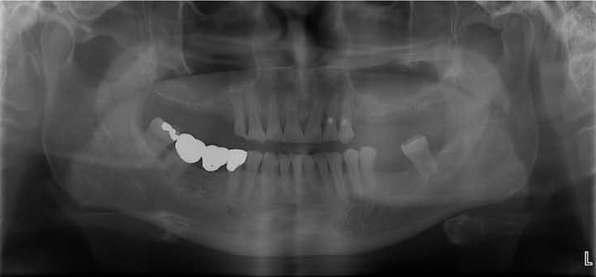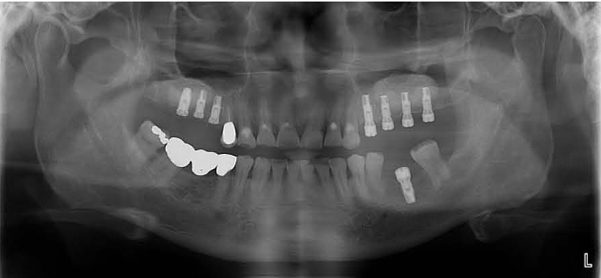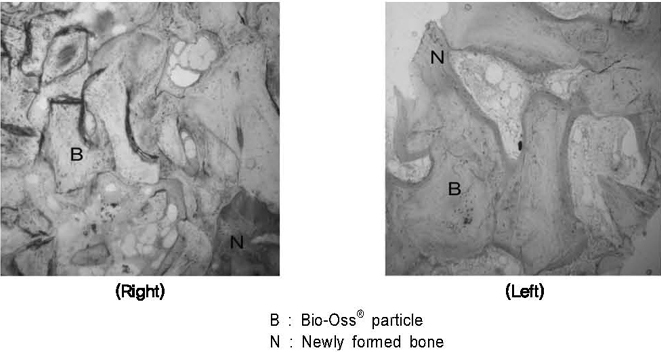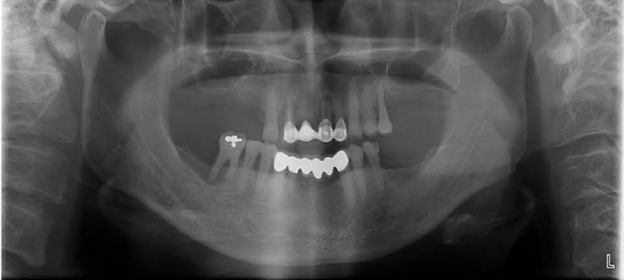J Korean Acad Periodontol.
2009 Mar;39(1):95-102. 10.5051/jkape.2009.39.1.95.
Maxillary sinus floor augmentation with anorganic bovine bone: Histologic evaluation in humans
- Affiliations
-
- 1Department of Periodontics, Samsung Medical Center, Sungkyunkwan University School of Medicine, Korea. sb123.kye@samsung.com
- KMID: 1783521
- DOI: http://doi.org/10.5051/jkape.2009.39.1.95
Abstract
-
PURPOSE: The aim of this report is to investigate the efficacy of anorganic bovine bone xenograft(Bio-Oss(R) ) at maxillary sinus floor augmentation.
MATERIALS AND METHODS
Two male patients who missed maxillary posterior teeth were included. They were performed maxillary sinus floor augmentation using anorganic bovine bone xenograft(Bio-Oss(R) ). After 10 or 13 months, the regenerated tissues were harvested using trephine drills with 2 or 4mm diameter and non-decalcified specimens were made. The specimens were examined histologically and histomorphometrically to investigate graft resorption and new bone formation.
RESULTS
Newly formed bone was in contact with Bio-Oss(R) particles directly without any gap between the bone and the particles. The proportions of newly formed bone were 23.4~25.3% in patient 1(Pt.1) and 28.8% in patient 2(Pt.2). And the proportions of remained Bio-Oss(R) were 29.7~30.2% in Pt.1 and 29.2% in Pt.2. The fixtures installed at augmented area showed good stability and the augmented bone height was maintained well.
CONCLUSION
Anorganic bovine bone xenograft(Bio-Oss(R) ) has high osteoconductivity and helps new bone formation, so that it can be used in maxillary sinus floor augmentation.
Figure
Cited by 2 articles
-
Clinical presentation of a horse-derived biomaterial and its Biocompatibility: A Clinical Case Report
Ki-Tae Koo, Jang-Yeol Park, Jun-Seok Park, Tae-Il Kim, Yang-Jo Seol, Yong-Moo Lee, Young Ku, In-Chul Rhyu, Chong-Pyoung Chung
J Korean Acad Periodontol. 2009;39(Suppl):287-291. doi: 10.5051/jkape.2009.39.S.287.Long-term results of new deproteinized bovine bone material in a maxillary sinus graft procedure
Seung-Yun Shin, You-Jeong Hwang, Jung-Hoon Kim, Yang-Jo Seol
J Periodontal Implant Sci. 2014;44(5):259-264. doi: 10.5051/jpis.2014.44.5.259.
Reference
-
1. Bays R. The pathophysiology and anatomy of edentulous bone loss. Reconstructive Preprosthetic Oral and Maxillofacial Surgery. 1986. 1:1–17.2. Galindo-Moreno P, Avila G, Fernandez-Barbero JE, et al. Evaluation of sinus floor elevation using a composite bone graft mixture. Clin Oral Impl Res. 2007. 18:376–382.
Article3. Zinner ID, Small SA. Maxillary sinus grafts and prosthetic management. Implant Dentistry:From Failure to Success. 2004. 1st edition. Hong kong: Quintessence Books;99–100.4. Kamada M, Shimazu K, Aoki H, et al. Maxillary sinusitis caused by oral implants. Practica Oto-Rhino-Laryngologic. 2003. 96:231–236.
Article5. Galindo-Moreno P, Sanchez-Fernandez E, Avila G, et al. Migration of implants into the maxillary sinus: two clinical cases. Int J Oral Maxillofac Implants. 2005. 20:291–295.6. Van den Bergh JPA, Ten Bruggenkate CM, Disch FJM, et al. Anatomical aspects of sinus floor elevation. Clin Oral Impl Res. 2000. 11:256–265.7. Jensen OT. The Sinus Bone Graft. 2006. 2nd edition. Quintessence Books;211–219.8. Davies JE. In vitro modeling of the bone/implant interface. Anatomical Record. 1996. 245:426–445.
Article9. Wallace SS, Froum SJ. Effect of Maxillary sinus augmentation on the survival of endosseous dental implants. A systematic review. Ann Periodontol. 2003. 8:328–343.
Article10. Del Fabbro M, Testori T, Francetti L, et al. Systematic review of survival rates for implants placed in the grafted maxillary sinus. Int J Periodontics Restorative Dent. 2004. 24:565–577.
Article11. Daelemans P, Hermans M, Godet F, et al. Autologous bone graft to augment the maxillary sinus in conjunction with immediate endosseous implants: a retrospective study up to 5 years. Int J Periodontics Restorative Dent. 1997. 17:27–39.12. Hallman M, Sennerby L, Lundgren S. A clinical and histologic evaluation of implant integration in the posterior maxilla after sinus floor augmentation with autogenous bone, bovine hydroxyapatite, or a 20:80 mixture. Int J Oral Maxillofac Implants. 2002. 17:635–643.13. Valentini P, Abensur DJ. Maxillary sinus grafting with anorganic bovine bone: A clinical report of long-term results. Int J Oral Maxillofac Implants. 2003. 18:556–560.14. Piattelli M, Favero GA, Scarano A, et al. Bone reactions to anorganic bovine bone(BioOss) used in sinus augmentation procedures: A histologic long-term report of 20 cases in humans. Int J Oral Maxillofac Implants. 1999. 14:835–840.15. Lee YM, Shin SY, Kim JY, et al. Bone reaction to bovine hydroxyapatite for maxillary sinus floor augmentation: Histologic results in humans. Int J Periodontics Restorative Dent. 2006. 26:471–481.16. Valentini P, Abensur D, Wenz B, et al. Sinus grafting with porous bone mineral(BioOss) for implant placement: A 5-year study on 15 patients. Int J Periodontics Restorative Dent. 2000. 20:245–253.17. Hammerle CHF, Chiantella GC, Karring T, et al. The effect of a deproteinized bovine bone mineral on bone regeneration around titanium dental implants. Clin Oral Impl Res. 1998. 9:151–162.
Article18. Valentini P, Abensur D, Densari D, et al. Histological evaluation of BioOss in a 2-stage sinus floor elevation and implantation procedure. A human case report. Clin Oral Impl Res. 1998. 9:59–64.19. Scarano A, Pecora G, Piattelli M, et al. Osseointegration in a sinus augmented with bovine porous mineral: Histological results in an implant retrieved 4 years after insertion. A case report. J Periodontol. 2004. 75:1161–1166.
Article
- Full Text Links
- Actions
-
Cited
- CITED
-
- Close
- Share
- Similar articles
-
- Maxillary sinus bone graft using particulated ramal autobone and bovine bone
- Maxillary sinus augmentation with bovine bone mineral (bio-oss.) and the maxillary tuberosity
- A Case of Maxillary Sinusitis after Sinus Floor Augmentation
- Comparison of immunohistochemical analysis on sinus augmentation using demineralized tooth graft and bovine bone
- Sinus floor augmentation at the time of tooth removal










